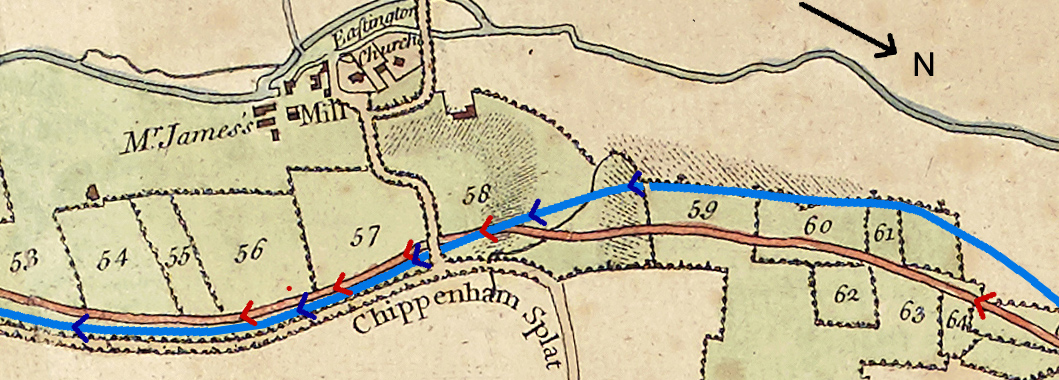Hugh Conway-Jones outlines the challenges faced by the builders of the flight of five locks that climb the hill past the village of Eastington. The positioning of the locks and the choice of levels had to take account of not only the natural topography but also the means of crossing a farm track, a stream and an important road. (This article was originally published in the Trow magazine, Autumn 2022.)

The plan of the flight approved by Parliament in March 1776 is shown in brown, and the route chosen by resident engineer Edmund Lingard in November that year is shown in blue. It seems that the approach to the first lock was moved close to a hedge to avoid dividing fields into small plots, and this also allowed the lock to be moved further up the valley to where a field access bridge could cross the cutting at the tail of the lock. In this position, the arch of the bridge only had to accommodate the width and height of a single barge and the approaches on either side needed less earthworks.
To cross the Oldbury Brook, there was a proposal to pass the brook under the canal through an inverse siphon, but Lingard decided to make the crossing on the level, and this fixed the height of the first lock (Westfield). Unfortunately it was soon found that the walls of this lock had 'come in' a few inches due to water pressure in the hillside behind, and the brickwork had to be partially rebuilt. Following good practice, the third lock (Pike) was sited so that the road to Eastington could cross a bridge at the tail of the lock, and this effectively determined the positions and levels of the other locks.
While construction of these locks was in progress, management was made more difficult by other complications. During 1777 the Stroudwater Committee became increasingly unhappy with resident engineer Edmund Lingard, and he was discharged in November 'for refusing to survey in such manner as he was directed'. Work continued, and the first cargo of coal delivered to Eastington was recorded on 14 Jan 1778. At this date, Dock Lock was still under construction; so it seems that early deliveries were discharged below the lock, and the coal yard adjoining Pike Bridge only came into use later.
In February 1778, Lingard was replaced by Thomas Frewin, but it was not long before his ability was also being questioned with regard to the level of the fourth lock (Blunder), and he too was discharged. From June 1778, construction work was supervised by Benjamin Grazebrook, a member of the Committee who had practical experience as a water supply contractor.
A consequence of all of these issues was that the second and third locks ended up deeper than average (Dock 11ft 1in and Pike 10ft 5in) while the fourth and fifth locks were much shallower (Blunder 7ft 7in and Newtown 7ft 6in). This inevitably caused water management problems in subsequent operation - but that is another story. For now, we can recognise that building this flight almost 250 years ago was a major achievement, and as restoration work by volunteers is going well, I feel sure that the manager in charge need have no fear of being discharged 'for refusing to survey in such manner as he was directed'.
Plan approved by Parliament, D1180/acc14247/1.
Plan of flight as built from c1880 OS map.
Lingard's survey 19-20 Nov 1776 is referred to in D1180/9/20 p24, but no details are recorded. This evidently included the new approach to the flight through Mr Baxter's land (D1180/1/1 p95) and the higher level of Newtown Lock (as built).
A proposal for a siphon for the Oldbury Brook is included in D1180/9/20 p55.
Westfield Lock 'coming in', D1180/1/1 p183.
Discharge of Mr Lingard, D1180/1/1 p163.
Dock Lock still under construction in 1778, D1180/1/1 p183.
Discharge of Mr Frewin, D1180/1/1 p212.
Lock heights from D1180/10/31.